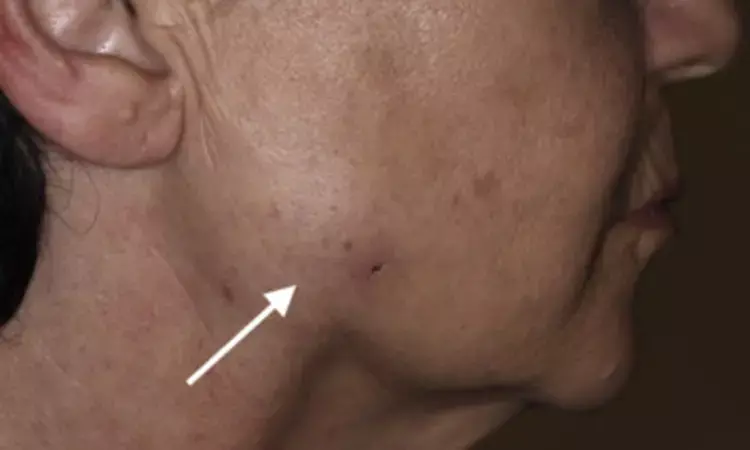- Home
- Medical news & Guidelines
- Anesthesiology
- Cardiology and CTVS
- Critical Care
- Dentistry
- Dermatology
- Diabetes and Endocrinology
- ENT
- Gastroenterology
- Medicine
- Nephrology
- Neurology
- Obstretics-Gynaecology
- Oncology
- Ophthalmology
- Orthopaedics
- Pediatrics-Neonatology
- Psychiatry
- Pulmonology
- Radiology
- Surgery
- Urology
- Laboratory Medicine
- Diet
- Nursing
- Paramedical
- Physiotherapy
- Health news
- Fact Check
- Bone Health Fact Check
- Brain Health Fact Check
- Cancer Related Fact Check
- Child Care Fact Check
- Dental and oral health fact check
- Diabetes and metabolic health fact check
- Diet and Nutrition Fact Check
- Eye and ENT Care Fact Check
- Fitness fact check
- Gut health fact check
- Heart health fact check
- Kidney health fact check
- Medical education fact check
- Men's health fact check
- Respiratory fact check
- Skin and hair care fact check
- Vaccine and Immunization fact check
- Women's health fact check
- AYUSH
- State News
- Andaman and Nicobar Islands
- Andhra Pradesh
- Arunachal Pradesh
- Assam
- Bihar
- Chandigarh
- Chattisgarh
- Dadra and Nagar Haveli
- Daman and Diu
- Delhi
- Goa
- Gujarat
- Haryana
- Himachal Pradesh
- Jammu & Kashmir
- Jharkhand
- Karnataka
- Kerala
- Ladakh
- Lakshadweep
- Madhya Pradesh
- Maharashtra
- Manipur
- Meghalaya
- Mizoram
- Nagaland
- Odisha
- Puducherry
- Punjab
- Rajasthan
- Sikkim
- Tamil Nadu
- Telangana
- Tripura
- Uttar Pradesh
- Uttrakhand
- West Bengal
- Medical Education
- Industry
MRI helps identify adverse Effects due to Hyaluronic Acid Filler- case report

Courtesy Becker et al., Advances in Oral and Maxillofacial Surgery
There are always complications in the field of aesthetic medicine. In a recent report published in the Advances in Oral and Maxillofacial Surgery, Dr Philipp Becker and his team reported a case of a 62-year-old patient who was injected with a hyaluronic acid filler in four places on the face, which led to acute and chronic infections in three places. The lesion was then detected and treated with the help of ultrasound and MRI scans.
"What is interesting about this case is that the same filler therapy in one session led to three different complications in a patient with an inconspicuous general medical history," wrote the group, led by Dr Philipp Becker from the department of oral and maxillofacial surgery at the Federal Armed Forces Hospital, Rübenacherstr in Germany.
Case Description:
The authors delineated the case of a 62-year-old healthy woman who went to the oral and maxillofacial surgery clinic after developing a hard, tender swelling near the right jaw angle. Three months earlier, her cheekbones and each side of her jaw had been injected with a hyaluronic acid filler. After a few days of soft tissue augmentation, the woman was presented with an inflammatory swelling over the left zygomatic arch which was treated with antibiotics. Shortly thereafter, a similar finding appeared on the left corner of the jaw. It was also improved after incision, drainage and several days of antiseptic irrigation. After the inflammation subsided, a few weeks later, she was again presented with a renewed inflammatory swelling in the area of the right angle of the jaw, which did not improve despite surgical drainage with oral antibiotic therapy and injections with hyaluronidase.
She was then admitted to Becker and colleagues clinic. During admission, she had an approximately 2 cm large, rough, painful swelling with restricted mouth opening (interincisal distance 15 mm).
Ultrasound revealed an approximately 20 × 15 mm encapsulated mass, which matched a granulomatous melted inflammation. To reduce the inflammation, the physicians administered intravenous ampicillin/sulbactam due to the closeness of the mass to the facial nerve, and an MRI scan was performed. The MRI findings showed a polylobulated lesion that measured 13 x 10 x 15 mm in the right masseter muscle. The findings were compatible with an inflammatory nodule which was then punctured and aspirated. They found no pus, secretions or blood in the aspiration. So the physicians diagnosed the accumulation of the injected mass for hyaluronic acid filler and not for an abscess. Due to the localization and extent of the findings, the physicians decided to continue the conservative intravenous antibiotic therapy, whereby the clinical symptoms regressed.
The authors concluded, "In the case of unsuccessful long-term antibiosis and unsuccessful hyaluronidase therapy, surgical resection would have been the last option if the symptoms persist."
They further added, "Proper medical training, knowledge of the patient and an experienced handling of the therapeutics used are basic requirements for success with the lowest possible complication rate of aesthetic medicine."
For further information:
Medical Dialogues Bureau consists of a team of passionate medical/scientific writers, led by doctors and healthcare researchers. Our team efforts to bring you updated and timely news about the important happenings of the medical and healthcare sector. Our editorial team can be reached at editorial@medicaldialogues.in.
Dr Kamal Kant Kohli-MBBS, DTCD- a chest specialist with more than 30 years of practice and a flair for writing clinical articles, Dr Kamal Kant Kohli joined Medical Dialogues as a Chief Editor of Medical News. Besides writing articles, as an editor, he proofreads and verifies all the medical content published on Medical Dialogues including those coming from journals, studies,medical conferences,guidelines etc. Email: drkohli@medicaldialogues.in. Contact no. 011-43720751


